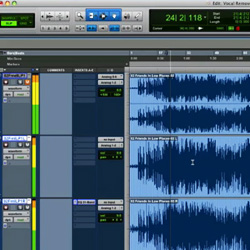Over the weekend, I received an email from one of my readers, Alan:
Hi Joe…I have a question for you. In some of your videos you discuss overlapping the WAV forms so that the cymbals continue to ring out.
Wouldn’t it be easier, if instead of grouping the cymbals with the other tracks to be edited, that you leave them alone? Or am I missing the point?
If you are grouping all the tracks together, for editing purposes on the kick or the snare, why include the cymbals?
I am confused as to why one would include the cymbals for a group editing, and take the risk that they don’t continue to ring out as originally played.
Thanks, Alan
This is a great question, Alan.
First, let me recap what Alan’s talking about. When I do drum editing, I group all the drum tracks together. So when I’m adjusting a snare hit, all the drum tracks are moved at the same time.
The problem you run into occasionally is that you need to do an edit on the snare hit after a big cymbal crash. It’s not uncommon for the edit to interrupt the “ring” of the cymbals, which can be fairly noticeable. With a little patience, you can make it work.
Back to Alan’s question. He’s asking why I don’t just leave the overhead tracks alone and not group them with the rest of the tracks.
One word – Phase
“What is phase?” you might ask. Phase is a measurement of time between two or more sources. If two signals are out of phase with each other, the result is a very thin, weird sound. (Think phaser guitar pedal.)
If drums have been recorded properly, then all the tracks should be in phase with one another.
As soon as you take some of those tracks and move them forward or backwards, by even a few milliseconds, your drums are now out of phase.
Your kick drum will suddenly lack punch and low end. The snare will lose its definition.
The overhead mics are arguably the most important parts of recording a drum kit. They capture the entire kit, not just the cymbals.
So if you move the snare drum without moving the overhead track as well, the snare will be hitting at slightly different moments in time, resulting in phase issues.
Nerd Alert
I know, I know. this is getting a bit nerdy…but it’s important stuff. Still not sure what I’m talking about? Here’s a bit of homework for you:
• Open up your DAW (Pro Tools, Logic…it doesn’t matter.)
• Import a song onto a stereo track.
• Duplicate that song onto a second stereo track.
• Zoom in and move one of the tracks to the right by a few milliseconds.
• Listen to what it does. Pretty weird, eh?
That is why I always group all of the drum tracks when drum editing. Phase issues can ruin a mix. Grouping your drum tracks will keep you out of trouble.
What phase problems do you run into when working on a song? Be sure to let us know by leaving a comment below!
Joe Gilder is a Nashville based engineer, musician, and producer who also provides training and advice at the Home Studio Corner.





















